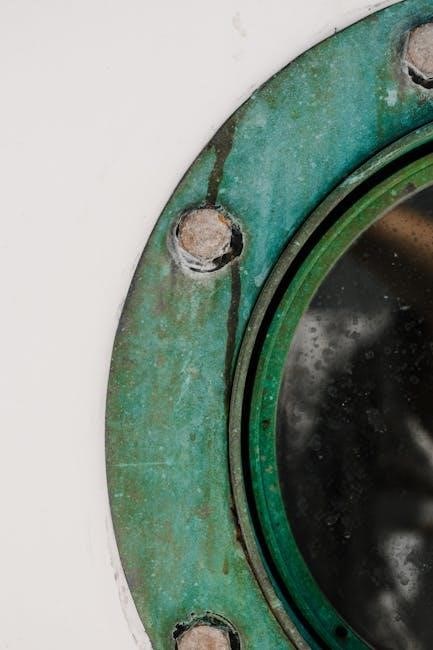Pilgrim 29ft Bunkhouse Slide Out: Manual Override Guide
Encountering a slide-out malfunction on your Pilgrim 29ft Bunkhouse can be frustrating, especially when you’re eager to hit the road․ This guide provides essential steps to manually override your slide-out system, empowering you to retract it safely without relying on electrical or hydraulic power․
Understanding Your RV Slide Out System
RV slide-out systems enhance living space but can face issues like dead batteries or motor malfunctions․ Manual override systems are crucial for such scenarios․ These systems bypass the electrical components, enabling you to retract the slide-out using hand tools․ Familiarize yourself with your Pilgrim 29ft Bunkhouse’s slide-out type and its manual operation․
Most slide-outs feature a manual retraction method, essential when the slide gets stuck․ Understanding the system prevents damage during manual operation․ Before attempting a manual override, consult your owner’s manual for specific instructions and safety precautions․ This ensures you’re aware of any model-specific nuances․

Different slide-out mechanisms, like rack and pinion or hydraulic slides, require distinct manual procedures․ Identifying your system type is the first step to a successful manual retraction․ This knowledge ensures you use the correct tools and techniques, minimizing the risk of damage to the slide-out components․
Always disconnect the power to the slide-out system before commencing manual operation․ This prevents electric backfeed, which could harm the system’s electrical components․ Understanding these basics will help you troubleshoot and safely operate your slide-out manually when needed․
Identifying the Slide Out Type
Identifying the slide-out type on your Pilgrim 29ft Bunkhouse is crucial for proper manual operation․ Common types include rack and pinion, hydraulic, and Schwintek (in-wall) slides, each requiring a different manual retraction approach․ Consult your RV owner’s manual for specific information on your slide-out system․
Rack and pinion slides often have a hex nut or extension rod connected to the electric actuator motor․ Hydraulic slides may require releasing pressure or using a specific valve․ Schwintek slides typically involve disengaging the motors to allow manual movement․
Visually inspect the slide-out mechanism to identify key components․ Look for gears, hydraulic cylinders, or visible motors․ The location of the motor and any manual override access points can also indicate the slide-out type․ This visual confirmation, combined with your owner’s manual, will help you accurately identify your system․
Understanding your slide-out type ensures you use the correct tools and procedures for manual retraction․ Attempting the wrong method can damage the system and lead to costly repairs․ Take the time to properly identify your slide-out type before proceeding with any manual operation․
If unsure, consult with an RV technician for assistance․ They can provide expert guidance and ensure you understand the specific requirements of your slide-out system․
Common Slide Out Problems
Several issues can prevent your Pilgrim 29ft Bunkhouse slide-out from functioning correctly․ A dead battery is a frequent culprit, as the slide-out motor relies on adequate power․ Faulty motors, whether due to wear and tear or electrical issues, can also cause the slide-out to fail․

Obstructions, such as debris or misaligned components, can hinder the slide-out’s movement․ Check for any visible obstructions before attempting to operate the slide-out․ Electrical problems, including blown fuses or wiring issues, can also disrupt the slide-out’s functionality․
Hydraulic systems may experience leaks or pressure loss, preventing the slide-out from extending or retracting properly․ In rack and pinion systems, stripped gears can render the motor ineffective․ Schwintek slides are prone to synchronization issues, causing the slide-out to bind or stall․
Transit bars, if not removed, will prevent the slide-out from moving․ Always ensure transit bars are disengaged before operation․ Overextending or retracting the slide-out beyond its limits can damage the components․
Identifying the specific problem is crucial for effective troubleshooting․ Consult your RV owner’s manual for guidance on diagnosing common issues and potential solutions․ A systematic approach can help pinpoint the cause of the malfunction and determine the appropriate course of action․

Safety Precautions Before Manual Operation
Prior to manually operating the slide-out on your Pilgrim 29ft Bunkhouse, prioritize safety to prevent injuries or damage․ Begin by disconnecting the RV from shore power and turning off the slide-out system to eliminate potential electrical hazards․ Consult your owner’s manual for specific safety recommendations related to your RV model․
Ensure the battery is disconnected to prevent electric backfeed that could harm the slide-out mechanism․ Verify that nothing obstructs the slide-out’s path, both inside and outside the RV․ Clear any furniture or objects that might interfere with its movement․
Wear appropriate safety gear, including gloves and eye protection, to protect yourself from potential hazards․ Have a second person assist you, if possible, to ensure smooth and controlled operation․ Never force the slide-out if you encounter significant resistance․
Carefully inspect the slide-out mechanism for any visible damage or obstructions before proceeding; If you notice any issues, address them before attempting manual operation․ Be mindful of pinch points and keep your hands and fingers clear of moving parts․
Understand the manual override procedure for your specific slide-out type and follow the instructions precisely․ Rushing or taking shortcuts can lead to accidents or further damage․ Exercise caution and proceed slowly and deliberately throughout the manual operation process․
Locating the Manual Override Mechanism
Finding the manual override on your Pilgrim 29ft Bunkhouse slide-out is crucial for operating it without power․ Start by consulting your RV’s owner’s manual, which often provides diagrams or specific instructions on the override location․ Typically, the override mechanism is near the slide-out motor․
For rack and pinion slides, check underneath the slide-out for a shaft with a hex nut or an extension rod․ This rod might require a manual crank․ For in-wall (Schwintek) slides, the motor access points are often behind the interior trim․
Examine the exterior and interior walls near the slide-out for access panels or hidden compartments․ Some models have a dedicated access point in the underbelly, covered by a removable panel․
If you have a hydraulic slide, the manual override might involve releasing pressure from the hydraulic pump or using a specific valve․ The pump is usually located in a storage compartment․
Once you find the mechanism, familiarize yourself with its operation․ Check if it requires a special tool, such as a crank handle or wrench․ Ensure you have the necessary tools ready before proceeding․ If you are unsure, consult online resources or contact an RV technician for guidance․
Tools Required for Manual Operation
Before attempting to manually retract the slide-out on your Pilgrim 29ft Bunkhouse, it’s essential to gather the necessary tools․ Having the right tools on hand will ensure a smoother and safer operation, minimizing the risk of damage to the slide-out mechanism․
First, consult your RV’s owner’s manual to identify any specific tools recommended by the manufacturer․ Commonly needed tools include a manual crank handle, which often comes with the RV, and is designed to fit the slide-out’s manual override․
Depending on the type of slide-out system, you might also need a socket wrench set with various sizes, typically ranging from 5/8″ to 3/4″․ An adjustable wrench can also be useful for different nut sizes․ A screwdriver set, including both Phillips head and flathead screwdrivers, might be required to remove access panels or disengage motor components․
Additionally, consider having work gloves for better grip and hand protection, and a flashlight or headlamp to illuminate the work area, especially if you’re operating in low-light conditions․ WD-40 or a similar lubricant can help loosen any stiff components․
Lastly, keep your RV’s toolkit nearby, as it might contain specialized tools specific to your model․ Double-checking your tool inventory before starting will save time and prevent frustration during the manual retraction process․
Step-by-Step Manual Retraction Procedure
Manually retracting the slide-out on your Pilgrim 29ft Bunkhouse requires careful execution to avoid damage․ Begin by consulting your owner’s manual for specific instructions related to your slide-out model, as procedures can vary․
First, disconnect the RV from shore power and ensure the battery is disconnected to prevent electrical backfeed, which could harm the slide-out system․ Locate the manual override mechanism, usually found near the slide-out motor, often beneath the slide-out section․
Disengage the motor brake or locking mechanism, as instructed in your manual․ This might involve removing screws or releasing a lever․ Connect the manual crank tool to the extension rod or designated point on the slide-out mechanism․
Begin turning the crank handle clockwise, using slow and steady movements․ Monitor the slide-out as it retracts, ensuring it moves evenly and without excessive resistance․ If you encounter significant resistance, stop and inspect for obstructions or mechanical issues․
Continue cranking until the slide-out is fully retracted and flush with the RV’s exterior wall․ Avoid over-cranking, as this can damage the slide components․ Once fully retracted, re-engage any locking mechanisms or motor brakes that were disengaged earlier, securing the slide-out in its retracted position․
Finally, perform a visual inspection to confirm the slide-out is properly sealed and secure before traveling․

Cranking the Slide Out Manually
Once you’ve located the manual override and prepared your tools, the process of manually cranking the slide-out on your Pilgrim 29ft Bunkhouse can begin․ This step requires patience and a feel for the mechanism to avoid causing damage․ Ensure the slide-out system is disengaged from its powered operation before proceeding․
Attach the appropriate crank handle or wrench to the designated point on the manual override, typically a hex nut or extension rod connected to the slide-out motor․ Begin turning the crank slowly and deliberately․ Note the direction you’re turning; usually, a clockwise rotation will retract the slide-out․
As you crank, listen for any unusual noises or grinding, which could indicate a problem․ Observe the movement of the slide-out to ensure it’s retracting evenly․ If one side appears to be lagging, stop and assess the situation․ It might be necessary to apply gentle pressure to the lagging side to encourage it to move in sync with the other․
Continue cranking, maintaining a steady rhythm․ Avoid sudden bursts of force, as this can strain the mechanism․ If the slide-out becomes increasingly difficult to crank, don’t force it․ Instead, double-check that all locking mechanisms are disengaged and that there are no external obstructions preventing movement․
Crank until the slide-out is fully retracted and flush with the RV’s wall․ At this point, you should feel increased resistance, signaling that the slide-out is in its final position․ Do not over-crank, as this can damage the gears or other components of the slide-out system․
Dealing with Resistance During Retraction
Encountering resistance while manually retracting the slide-out on your Pilgrim 29ft Bunkhouse is a common issue, and addressing it correctly is crucial to prevent damage․ First, stop cranking immediately if you feel significant resistance; Forcing the mechanism could lead to stripped gears or bent components, resulting in costly repairs․
Begin by carefully inspecting the slide-out, both inside and outside the RV․ Look for any obstructions that might be hindering its movement, such as furniture that has shifted, debris that has accumulated, or misaligned rollers․ Remove any obstructions you find․
Next, check the slide-out rails and mechanisms for proper lubrication․ Apply a silicone-based lubricant to the rails and any moving parts you can access․ This can significantly reduce friction and make the retraction process smoother․
If the resistance persists, examine the slide-out for any signs of structural damage․ Look for bent supports, damaged rollers, or warped slide-out walls․ If you spot any damage, it may be necessary to consult a professional RV technician before attempting further manual retraction․
Another potential cause of resistance is an uneven load distribution within the slide-out․ Try shifting the weight inside the slide-out to see if that alleviates the pressure․ If possible, have someone gently push or pull on the slide-out while you crank to help overcome the resistance․ Remember to proceed slowly and cautiously, and if the resistance remains unyielding, seek professional assistance․
Avoiding Damage During Manual Operation
Manually operating the slide-out on your Pilgrim 29ft Bunkhouse requires caution to prevent damage to the mechanism and surrounding structure․ First, always consult your RV’s owner’s manual for specific instructions related to your slide-out model․ Understanding the system’s design is crucial for safe manual operation․
Before starting, ensure the area around the slide-out is clear of obstructions, both inside and outside the RV․ Check for furniture, debris, or anything that could impede the slide-out’s movement․ Never force the manual crank if you encounter significant resistance․
When cranking, maintain a slow and steady pace․ Avoid jerky or abrupt movements, as these can strain the mechanism․ Listen carefully for any unusual noises, such as grinding or popping, which could indicate a problem․ If you hear anything concerning, stop immediately and investigate․
Be mindful of the slide-out’s travel limits․ Over-extending or over-retracting the slide-out can cause serious damage to the gears, rails, or seals․ Monitor the slide-out’s position closely as you crank, and stop when it reaches its fully retracted position․ Do not continue cranking once it’s flush with the RV wall․
Finally, after manual operation, inspect the slide-out for any signs of damage, such as bent components, loose screws, or damaged seals․ Address any issues promptly to prevent further problems․ If you’re unsure about any aspect of the manual operation, seek guidance from a qualified RV technician․
Post-Operation Checks and Maintenance
After successfully retracting your Pilgrim 29ft Bunkhouse slide-out manually, a thorough inspection and proper maintenance are crucial to ensure its continued functionality․ Begin by visually examining the entire slide-out mechanism, both inside and outside the RV․ Look for any signs of damage, such as bent components, loose hardware, or damaged seals․
Pay close attention to the slide rails and rollers․ Ensure they are clean and properly lubricated․ Use a silicone-based lubricant specifically designed for RV slide-outs․ This will help reduce friction and prevent future problems․ Check the seals around the slide-out for any tears, cracks, or gaps․ Damaged seals can allow water and debris to enter, leading to further issues․
Inspect the manual override mechanism itself․ Make sure all components are securely in place and that the crank handle is stored safely․ Test the electrical system associated with the slide-out․ Check fuses and wiring connections to ensure they are intact and functioning correctly․ If you notice any electrical issues, consult a qualified RV technician․
Finally, consult your RV’s owner’s manual for recommended maintenance schedules and procedures․ Regularly inspect and lubricate the slide-out mechanism to prevent future problems․ By performing these post-operation checks and adhering to a consistent maintenance routine, you can extend the life of your slide-out system and avoid unexpected breakdowns․